
Marbella
Marbella
If you’re looking for a slice of paradise this summer, you’re well advised to place Marbella at the top of your list of potential destinations. Why? Few holiday resorts have all the ideals of a dream vacation wrapped in one package the way this Andalusian town does.
Immaculate weather all year round, magnificent beaches, plenty of indoor and outdoor activities and a scintillating nightlife are just a few of the reasons it is one of Spain’s most important tourist magnets and a veritable playground for the rich and famous. Many luxury yachts and cruise ships have made Marbella a customary port of call.
Sightseeing and activities
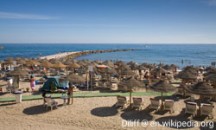
Strolling along the 44 odd kilometres of fine sands that define Marbella’s beaches it’s not hard to see why this municipality sitting between Gibraltar and Malaga is a hot tourist favourite.
Not only will you have the endless blue waters of the Mediterranean stretched out before you, you’ll be able to feast your eyes on the harbour and the many vessels anchored there. The dreamy breeze blowing in from the sea will ensure you are not overwhelmed by the sunny clime.
At the Guadalmina and Cabopino beaches you can lie down and let all your cares evaporate as your skin is turned a rich bronze and have a dip in the tepid waters when it gets a bit much. To further treat yourself why not visit local spas and beauty centres where your body and mind can be put at total ease?
Water sport freaks will be thrilled to know they can kayak in the sea and even those with no prior experience can get the basics with a few lessons at seafront kayaking clubs.
Those more interested in sports on land, especially golf enthusiasts, will be happy to learn of the numerous golf courses Marbella has. Among them is the Marbella Golf and Country Club, ranked among the country’s best courses. Those who want to learn the game can pop by the La Quinta Golf Academy for lessons.
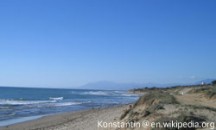
Few tourists who visit Marbella leave without learning a few Flamenco steps and it would be a shame if you did. This traditional Spanish dance and its associated music is performed at a number of establishments in this coastal city including the La Plaza Restaurant, where you can have a sumptuous meal as you admire the artists and their dancers going through their paces.
At the Tablao Flamenco Ana Maria you can not only watch an array of talented performers, you can get a class or two so that you can confidently join in the dancing. If you’re keen on taking it a step further, you can sign up at dance schools such as Marbella Dance School and La Clave Dance School.
A one-of-a-kind experience awaits you should you choose to take a cruise around the nearby Bay of Gibraltar. While your vessel sails along, don’t be surprised when a school of eager dolphins appears in the water to escort you on your trip. Another place you simply must visit, especially if you’ll be bringing the kids along, is the Fuengirola Zoo. There are over 140 different animal species waiting to greet you.
Events
How about a Greek cultural experience in Spain? If you’re not averse to this idea, then you need to visit Poco Loco on a Wednesday night for the Greek Night; even if it’s just for the fantastic cuisine.
Lloret De Mar
Tucked away in the north-eastern corner of Barcelona is one of Spain’s most sought-after resort cities, Lloret De Mar. As with most other such towns that lie on the edge of the Mediterranean Sea, you can expect picturesque beaches with pure sands, gentle breeze and dazzling sunsets.
And even when the sun does go down, the party goes on; this part of the Costa Brava does not sleep and is famous for its vibrant nightlife that only dies out in the wee hours of the morning. Which is not to say adrenaline junkies will be disappointed; au contraire, there are plenty of outdoor activities and sports designed just for them.
Sightseeing and activities
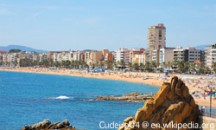 Like we said, thrill-seekers will be glad they chose Lloret De Mar as their holiday destination. What with activities like sea kayaking, snorkelling and diving that will lead you to expend your reserves of energy as you explore the waters from above and below.
Like we said, thrill-seekers will be glad they chose Lloret De Mar as their holiday destination. What with activities like sea kayaking, snorkelling and diving that will lead you to expend your reserves of energy as you explore the waters from above and below.
You will find beautiful small coves and a number of caves as well as feast your eyes on several colourful fish species and specimens of marine life. Few things get the adrenalin surging like waterskiing or parasailing on the Mediterranean waters. The winds off the coast of Lloret De Mar are perfect for kite surfing and sailing as well.
Jet skis are also available for those who have a need for speed. And if you’re up for exploration on foot, you can participate in a spot of hiking or Nordic walking through the exciting trails that will take you from the coast to the lush pine and holm-oak forests of the interior.
You can rent a bike if you prefer to traverse the rich landscape on two wheels. Golfing enthusiasts and those who don’t mind trying their hand at the 18 holes are welcome to do so on a number of world class golf courses.
After these exertions you can pamper yourself as you improve your wellbeing with a trip to a spa and wellness centre. Enjoy a series of natural treatments from various parts of the world designed to get the kinks out of your back and the stress out of your mind.
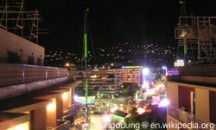
You can further relax by visiting one of the many small cafes or restaurants to grab a bite. When night falls, Lloret De Mar comes alive with many lively bars and nightclubs beckoning revellers.
If you like to spoil yourself on the finer things, there’s no better place to do this than in Lloret De Mar’s bountiful shopping precinct. There are few greater feelings than getting yourself those designer accessories you’ve always wanted while enjoying the perfect Mediterranean clime.
Mango, Cello and Pepe are just a few of the designer outlets you can expect to find on the St. Pere shopping street. And to replenish the energy you spend zipping about from shop to shop there are a number of cafes and restaurants serving tantalizing repasts from all over the world.
Events
Every summer the Clon Festival comes to Lloret De Mar and there you can catch world famous bands like Coldplay and Metallica live on stage. If you happen to be around on the 2nd of October you’ll have a chance to watch the International Petanque Championship.
Lanzarote
We present to you the eastern-most and arguably the most captivating of the Canary Islands, Lanzarote. It is without a doubt the youngest, having been reformed by volcanic eruptions in the 18th century.
The rich black volcanic soil that is seen throughout the isle is testimony to its amazingly recent birth. It offers eager holidaymakers plenty to facilitate their pleasure and relaxation as well as many astounding sites; a true all-in-one destination.
Sightseeing and activities
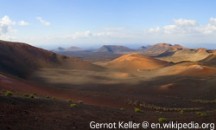
One of the most intriguing features of Lanzarote is the lunar landscape of the Timanfaya National Park that is covered with pieces of solidified lava and ash. Believe it or not, there are places that are still warm from the volcanic activities of centuries ago.
It’s therefore not surprising that locals claim that their beloved island was the last piece in the creation puzzle that God left till late. The volcanic soils have proved highly conducive for agriculture as is evidenced by the large number of fruit plantations and vineyards that dot the hinterland.
In Geria the sight of vineyards blossoming while sandwiched in between two volcanic craters continues to mesmerize visitors. Surrounded by their low, whitewashed walls and forming beautiful curvy green-white patterns, they are indeed a wonder to behold.
A number of monuments can still be found on the island’s former capital Teguise though the majority of them were destroyed by pirates. These include the Castillo de Santa Barbara and a couple of grand manors.
These distractions aside, what visitors to Lanzarote are mainly after is an afternoon of basking in the abundant Mediterranean sun on the island’s delicious beaches. At the Las Playas del Sur beach they will find just what they’re after with 20 kilometres of soft sands. Papagayo Beach serves up some mouth watering scenery comprising of the Hacha Grande and steep cliffs.
Playa Blanca offers pure white sands and waters clear enough to see through. For those who can’t resist reaching for a surf board whenever they’re near sea water, the beaches of Arrieta offer some magnificent waves for their enjoyment. La Santa, off the village of Tinajo is also ideal for surfing. Other activities you can indulge in while here include yachting and sailing the Mediterranean aboard a luxury cruiser.
Those into fishing as a sport as well as divers are encouraged to make their way to the coast of La Isleta, a tiny island next to Lanzarote. Want to completely relax in a thermal spa? A visit to Peurto del Carmen is just what you need.
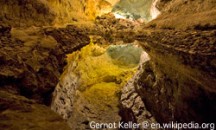
Other must-see sites include the volcanic cave of Cueva de los Verdes, the cactus garden with more than 10,000 species of the plant called simply Jardin de los Cactus and Jameos del Agua, a transformed lava tube.
These two features are the creations of renowned architect Cesar Manrique who is fondly referred to as the father of Lanzarote. If you’re into fine art or simply want to get better acquainted with local culture, you might want to pass by the Castillo de San Jose, an international museum of modern art.
With a seafront packed with modern hotels and apartments, you will not need to look far to find comfortable accommodation to suit your individual needs.
Gran Canaria
This is one of the islands that make up the Canary Islands but more importantly it is a gorgeous getaway that redefines the meaning of the word ‘scenic’. And it has the perfect weather to match; temperatures here average 20°C in winter and about 26°C in summer and there are hardly ever clouds in sight, especially between June and September.
Gran Canaria’s landscape is multifaceted and it has much more to offer than amazing beaches. Visitors who head out to this tourist hotspot will find plenty to see and do as well as excellent conditions for complete R&R. Small wonder over 2 million travellers troop into Gran Canaria every year.
Sightseeing and activities
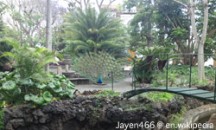
It’s not by chance that no other place but Gran Canaria is referred to as ‘The Small Continent’. Where else can you find your typical coastal scene; palm trees, sandy beaches, blue sea waters etc, in the same place as snow-capped mountains and dense jungle replete with diverse plant species, and, get this, the curvy sand dunes typical of deserts? And all on a tiny round island a mere 50km in diameter? Sightseeing is therefore naturally the priority of most of the island’s visitors.
So forget the sunbathing for a moment and picture yourself hiking up the mountain ranges and suddenly coming across a village over 500 metres above sea level. As you wonder just how they built such fine colonial homes so high up, you can admire the stunning scenery around you as well.
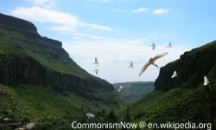
Before you hit the beaches why not venture into the old town of Arucas? Here you will find lovely, tranquil parks and the Montaña de Arucas volcano as well as some scenic bays.
You could also take a detour to Santa Maria de Guia in the north and visit the fascinating Cenobio de Valeròn caves. The fishing village of Arinaga to the south offers the perfect setting for a romantic getaway. On quitting the villages you can hike through some of Gran Canaria’s natural parks to become one with nature.
On descending, you will be embraced by the balmy coastal air and find yourself with a wide selection of beaches to choose from. Maspalomas is one of Gran Canaria’s most beautiful beaches and is a refuge for residents of other parts of Europe when the winter is at its chilliest. Nothing can bring greater pleasure than promenading along its 6 kilometres of fine white sand while swallowing the sweet Mediterranean breeze.
Or simply enjoying the shade of the palm trees that adorn the several oases on this part of the island. If you are looking for a more secluded area where you can read your novel in peace or nod off quietly, San Agustin Beach is the place to go. Playa de las Nieves has high snow capped peaks just behind it and makes for breathtaking viewing.
A number of water sports are held along these beaches including sport fishing and diving. Up for a round of golf? There are up to 8 different courses for you to choose from including Las Palmeras Golf, Maspalomas Golf and Salobre Golf & Resort. Most of these are designed to meet international standards meaning they are suitable for seasoned golfers and beginners alike.
Events
Among the events you can include in your Gran Canaria itinerary are the lively Maspalomas International Carnival that happens in mid-February at the town of San Bartolome de Tirjana and the Fiestas del Charco festival that takes place every September.
Fuerteventura
Sandwiched between the islands of Gran Canaria and Lanzarote is the oldest of the Canary Islands; a truly well-endowed tourist resort boasting over 150 scenic beaches. Fuerteventura’s constantly busy ports add to the picturesque coastline of this former French colony. Needless to say, one of the island’s key attractions is its wonderful shiny all year round weather. Even in winter temperatures hover between 22 and 15°C. This makes it a favourite destination for many as the climate allows for a host of outdoor activities and sightseeing.
Sightseeing and activities
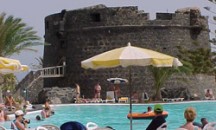 Organized trips through this island’s varied terrain are a tourist favourite. A good number of the visitors here will hire a 4×4 or motorbike and use it to traverse the rugged, mountainous landscape as they explore the island’s natural parks.
Organized trips through this island’s varied terrain are a tourist favourite. A good number of the visitors here will hire a 4×4 or motorbike and use it to traverse the rugged, mountainous landscape as they explore the island’s natural parks.
And indeed there are many of these reserves on Fuerteventura, set up to protect the rich plant and animal species found here. Parque Rural de Betancuria, Parque Natural de Jandia and Parque Natural de las Dunas de Corralejo are just a few of them. Apart from diverse plant species found especially at the popular Playa del Matorral, these parks boast a number of volcanic mountains and unique volcanic rock features.
Surfers will want to make Fuerteventura their holiday destination of choice as the waves off its coast are simply perfect for this sport. In fact, it is a key part of the surfing World Cup circuit. The bountiful wind which creates these waves is also a boon for wind and kite surfers. If you’re one of them you should head to Corralejo or Playas del Sotavento. Other water sports such as sailing and kayaking are also available for the more experienced and those who are eager to learn.
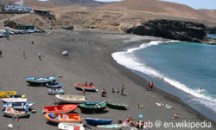
The plethora of interesting features on the seabed next to this locale make it a favourite among divers. Jandia Beach is especially suited for diving as a rich diversity of marine life can be viewed there through crystal-clear waters.
For those who long for a secluded stretch of beach where they can while away the day, there is the ‘Lonely Paradise’ or Lobos Island. It was formerly home to a large seal colony but is now only inhabited by a small fishing community.
A visit to the town of Betancuria is definitely worth the trouble as you will get to see the majestic Cathedral that was constructed in 1410 and contains many fascinating works of art. There is also an archaeological museum here for you to boost your bank of historical information.
Events
During the International Symposium of Sculpture held every year, artists from all over the world come to the open air sculpture park in the island’s capital, Puerto del Rosario, to display their works. The processions and street parties of El Carnaval de Canarias, also held in Puerto del Rosario are simply amazing, as are the music, dancing and fireworks of the
San Juan festival which takes place every June. If you’re an avid and able swimmer you can participate in the annual swim from Lobos Island to Fuerteventura which brings together medal-winning pros and amateurs who are in it for kicks.
Costa Dorada
Of all the Mediterranean seaside resorts Costa Dorada offers its visitors something over and above the average. A seemingly endless coastline where shimmering turquoise waters meet exceptionally fine sands is really just the tip of the iceberg.
If you venture further inland you will find amazing scenery and charming little villages, each showcasing captivating architecture. The ‘Golden Coast’ as the name translates, is choke-full of things to do and sites to see, small wonder it ranks among Spain’s most popular holiday destinations.
Sightseeing and activities
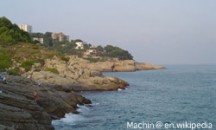
Most of the beaches on this part of Catalonia provide ideal grounds for leisurely strolls, sunbathing and swimming; the essentials of any coastal vacation. The sands are just what your kids need to sharpen their castle-building skills as well.
Your kids are also guaranteed to have the time of their lives at the nearby Universal Studios Port Aventura which offers them plenty of rides and shows. They will be equally thrilled with the numerous water rides at La Pineda.
And when the day is done and you want to unwind with a nice meal and your drink of choice in ambient surroundings, you will have many high quality establishments to choose from. There you will have your favourite variety of seafood prepared by seasoned chefs. Those looking for a place to shake a leg will find the Barcelona nightclubs perfect for the occasion.
Golfing enthusiasts will be thrilled to know that they can find their favourite 18 holes while enjoying the holiday of a lifetime in Costa Dorada. What can be more enjoyable than traversing a rich green course under the wonderful Mediterranean weather? If this sounds heavenly, then you must plan a visit to Panoramica Golf Course. This baby was designed by the renowned Bernhard Langer and sports such features as four sets of forward tees and brilliant practice facilities.
The Bonmont Golf Course is another course worth checking out that is suitable for both learners and seasoned pros. Be warned however that you will be distracted by unbelievable views of the coast as you play.
Leaving the Catalonian coast without journeying inland is missing out on a wealth of touristic delights. For starters there is the Ebro Delta that encompasses many unique geological features including sand dunes, fresh and salt water lakes, riverbank woods and fluvial islands within its 320 square kilometres. It really is a goldmine for nature lovers, rich in flora and fauna.
There are over 300 bird species that have made this natural park their home, including the elegant flamingo which resides on the more secluded lagoons. You can traverse this engrossing landscape by ferry, by mountain bike or on foot. After you’ve had your fill of the jungle, you can proceed to the towns of the towns Tarragona and Reus where you can soak up on Catalan history and culture. Sites of interest include the ruins of Tarragona, the Jewish quarter in Reus and the several archaeological museums in this town.
If you’re looking for an excuse to let your hair down and party the night away, then you need to pencil in a visit to the popular Sitges resort. You are more likely than not to find one celebration or the other happening here as cultural events and festivals are the order of the day. Sitges plays host to an extremely enjoyable carnival as well as the Corpus Christi, the International Festival of Fantastic and Horror Cinema.
Costa Del Sol
The only way to describe Costa Del Sol is a tourist’s paradise. Everything you see in your mind when you think about a dream vacation is wrapped up in this beautiful, well endowed Andalusian region. This ‘Coast of the Sun’ comprises of immaculate beaches, breathtaking landscapes, warm people, excellent cuisine and an enormous range of luxurious accommodation. There is simply an endless list of things to see and activities to do in this celebrated resort.
Sightseeing and activities
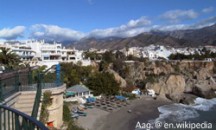
As with every seaside resort, Costa Del Sol promises you hours of sunbathing in fine Mediterranean climate and long walks on powdery white sands as the crystal clear waters caress your toes.
To say the views from Costa Del Sol’s shoreline are sublime almost amounts to an understatement what with the perpetually cloudless sky, waving palm trees and the sun peaking behind jagged cliffs.
At Algarrobo Beach you can have a splash in the warm frothy sea waters or just soak up some rays. Seafront eateries ensure that you’re properly nourished as you explore this coastal paradise and be sure to ask for pescaito or any speciality that includes fish such as the Fried Fish Malaga Style, you’ll love it.
To enjoy the views from bird’s eye view, take a cable car trip, descending towards the coast from the top of Monte Calamorro. If you are lucky to go on a clear day, you will be able to see as far as Gibraltar and the North African coast. Before descending you can grab a bite at a cafeteria with a terrace that overlooks the coast. Though the journey is a mere 15 minutes long, it’s definitely worth the ticket price.
But apart from sight-seeing, there is plenty more you can look forward to when in this part of the Spanish province of Malaga. If you came along with your young ones, what better way to treat them than taking them to Tivoli World? Here they will have an assortment of rides at their disposal as well as some really fascinating shows. You could also take them to the Benalmadena Sea Life Aquarium where they can get a closer look at real sharks and sea snakes. There is also a wealth of information available to visitors about sea life.
Events
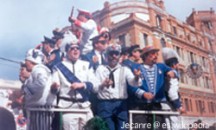
When the sun falls, Costa Del Sol comes alive with a selection of bars and nightclubs to help night owls have a good time.
One of the liveliest joints is Reinas which features entertainment provided by talented local artists to go with your poison of choice. It is a particular favourite for celebrities.
At the Vino Mio you will find a cosy, intimate ambiance and be serenaded by a host of local and international performers as you enjoy your favourite drink and excellent Spanish cuisine. If you time your visit right you will catch the Flamenco shows that have made this spot very popular among locals and visitors.
For those who like to have the comforts of home, there are a number of malls that provide a relaxing shopping experience as well as indoor recreational activities such as bowling.
Before the passing of Lent, residents and visitors to Costa Del Sol are treated to a number of carnivals, the most anticipated of which is the Cadiz Carnival. The Seville Spring Fair is marked by plenty of music and dancing and takes place every year around Easter.
Pousadas
Once there was a man who had a dream to preserve the heritage of his country. His name was Antonio Ferro. He was a Minister in the Portuguese Government. Portugal is landmarked by beautiful buildings of historic value and of cultural interest. It would be a shame not to share these spectacular pieces of history with the rest of the world, as the Government may not always be in a position to maintain these heritage sites.
Antonio Ferro’s dream was realised in 1940 when he initiated a project that would forever change the way in which the whole world can relive history on a daily base. In the process, preserve the history of the country.
Mr Ferro started a group of inns, giving it the Portuguese name: Pousada. Pousada is the Portuguese word meaning Inn. He converted castles, palaces, fortresses, monasteries, convents and museums into hotels that would ultimately preserve the history of the building.
The first Pousada opened in 1941 and is still operational to this day. For more than 60 years the Government owned the hotels, but privatised it in 2003 due to financial and management reasons.
In 1995, the American Society of Travel Agents (ASTA) and the Smithsonian Foundation awarded the Pousadas with the annual prize for an Institution that plays an active part in protecting cultural heritage sites for tourism purposes.
Categorisation
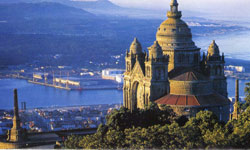 There are four categories of Pousadas and totals 44 Pousadas. The first category is the Historic Pousadas. National monuments that are well preserved such as convents, castles and fortresses are used for the Pousadas. The buildings are still in their original state and design.
There are four categories of Pousadas and totals 44 Pousadas. The first category is the Historic Pousadas. National monuments that are well preserved such as convents, castles and fortresses are used for the Pousadas. The buildings are still in their original state and design.
The second group is also historic buildings such as castles, palaces and monasteries, but they are not in their original state anymore. These buildings were renovated at some stage to make it more contemporary with modern designs and facilities.
Pousadas located in a romantic and unique atmosphere makes out the third group of Pousadas: The Charm Pousadas.
Lastly, there is the Nature Pousadas. These buildings are located in natural surroundings, such as the countryside.
Locations
Pousadas are situated all over Portugal. The regions where you can locate them are Alentejo, the Algarve, Azores, the Central Portuguese region, Lisbon and the Northern regions of Portugal. Although Pousadas are currently only found in Portugal, a long-term plan exists to open Pousadas in all locations that were formerly under Portuguese rule.
Events and Cuisine
Knowing that the Pousadas are actual castles, fortresses and palaces from a bygone era, imagine having your dream wedding and be the prince and princess of your own castle.
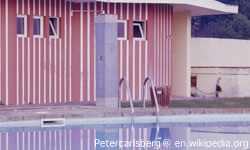
Pousadas are the perfect place to create that dream. Rooms are available for your wedding night and honeymoon. Pousadas are open for bookings to host weddings, conferences, team building and many other events.
You can even make it private for the exclusive use for you and your guest for the duration of your stay. Each Pousada has its own restaurant with world renowned chefs and offers cuisine specific to each region. The restaurants are open daily and available to the whole public, not only patrons in the Pousada.
The Portuguese Pousadas are dream venues for any occasion and a wonderful way to experience history. Here everyone is a gust and each person is special.
Porto Santo
Porto Santo was discovered in 1418 and is part of the Madeira Island group, an autonomous region from Portugal that has their own government. Porto Santo is the second largest of the island group and one of the best kept secrets of Madeira.
Named The Golden Island, it has less lush green vegetation than the island of Madeira. In fact, it is quite dry and barren on this island. Thousand of trees were planted over the island to prevent erosion. However, it has a beach that stretches for 9 kilometres on the southern coast and is ideal for beach resorts, hence the nickname of the Golden Island.
Attractions
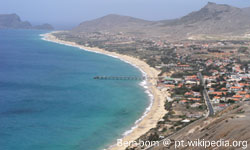
Even though Porto Santo is smaller and less inhabited than Madeira, it has surprisingly plenty of tourist attractions. There are many historic buildings dating back from the first settlers of the island after its discovery.
The Governor House was home to Bartolomeus Perstrelo, first resident and governor of Porto Santo. He was also the father-n-law to Christopher Columbus, who married his daughter after settling on Porto Santo.
Columbus Museum was formerly the home of Christopher Columbus, the famous explorer. He later relocated to Madeira Island from where he could better administrate his expeditions. His house is now a museum displaying navigational maps and exploring equipment.
The Town hall also dates from the 14th century, but was rebuilt and enlarged a few times. In the town you will also find the Cathedral dating back to the 15th century. It was originally a small chapel of which only a 16th century painting remains as evidence of the original building.
The Church of our Lady of Sorrows is a shrine to the Virgin Mary and is famous for the aquamarine medallion embedded on the white facades of the building.
On the peak of a volcano mountain, you can view the fort that was built there. It is the Pico de Castello. It offers a full view of the island and was used to protect the island against pirate attacks.
The harbour is the activity hub and the place to be to enjoy your favourite water sports. This is where all the equipment needed for sailing, diving and canoeing is safely anchored.
Activities
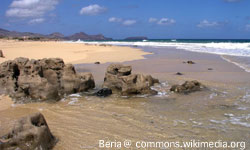
Activities range from sunbathing on the golden beaches, to taking part in water activities and hiking through trail, enjoying the natural and volcanic scenery of the island.
For the golf enthusiast, there is Porto Santo golf course. This course is one of the best in all of Portugal. The golf course also includes sauna and Jacuzzi facilities and a pro shop. Or relax at the modern clubhouse with a bar and restaurant.
Or enjoy the water sport activities at the harbour. Here you can enjoy sailing and surfing or book a yacht if you don’t own one, to relax on the gorgeous blue sea with sundowners. Or go out on a boat for some deep sea diving or for whale watching with qualified guides.
Accommodation
Porto Santo has no shortage on luxury hotels. All hotels are top rated and close to all amenities. The hotels are of international standard and offers great holiday packages to choose from. Hotels often include spa facilities and restaurants in which you can enjoy a relaxing holiday and culinary treats.
If you prefer a more personal touch, rent a private villa or apartment on the island. It is of high standard and often situated in locations with breathtaking views.
Enjoy the diverse history and beauty that the island has to offer and unwind in the natural tranquillity. Treat all your senses with the splendour of nature, great food and warm hospitality. You owe it to yourself to discover this jewel of Portugal.
Madeira
The Islands of Madeira are situated about 640 kilometres southwest of Lisbon, Portugal. This group of four islands is one of two autonomous Portuguese regions, meaning they have their own governments and are independent from the Portuguese main land. The other autonomous group of islands are the Azores.
There are four islands in this group, namely Madeira, Porto Santo, Desertas and Selvagem. Madeira is the main island and most of the civilisation and activity takes place here. The other three islands should not be disregarded as it features its own unique heritage and attractions.
Attractions
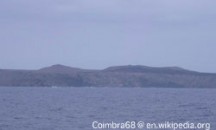
On the island of Porto Santo, you will find the museum of Christopher Columbus, the famous explorer. This museum used to be his house, but now display a collection of navigational maps and exploring equipment.
A church dating back to the 15th century, the Church of Our Lady of Sorrows is situated on this island and is known for the aquamarine medallion embedded into the white facade of the baroque style building.
The island of Desertas is uninhabited and is a nature reserve. The island is of volcanic origin and no source of fresh water is available. The only possible tourist attraction is the natural and indigenous plant growth, only through special authorisation.
The island of Selvagem is mainly uninhabited. It is known for the beautiful untouched fauna and flora and is only manned by a few sentries to guard the island. They are relieved every two weeks.
The island Madeira is the largest of the four islands and is a popular tourist destination. It is known for its beautiful beachfronts and resorts which are surrounded by mountains and cliffs. A famous attraction is the New Years’ celebrations with the largest display of fireworks in the world. This celebration was noted in the Guinness Book of Records in 2006.
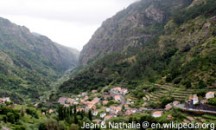
Madeira is host to a wealth of villages, all contributing to the heritage and atmosphere of the Madeira Islands. Along with the quaint villages, you will find yourself in breathtaking natural scenery and formations from volcanic activity.
Many of the villages are formed around the volcanic formations and the peaks of the mountains are used as viewpoints over the magnificent islands and gorgeous sea.
One such village is Curral das Freiras, a village in Central Madeira that lies in a valley and surrounded by extinct volcanoes. The village of Serra de Argua is located in the interior of the island and you need to cross a canyon to get to it. Hiking to the village you will pass waterfalls and cliffs and experience the mountain life.
Fuchal is the capital of Madeira and has a very busy City Square. The square is paved with tiles made from volcanic rock. It offers many tourist attractions like the City Hall which dates from the 18th century. You will also find historic churches and museums in Fuchal, such as the 15th century Cathedral, the Monte Palace Tropical Gardens and the Botanical Gardens.
Many of the towns are built around historic buildings dating from the 15th century. There are too many to mention here, but each town offers a piece of their history and is an attraction in own right.
Activities
With the perfect island weather, golf is a favourite activity. There are two internationally recognised golf courses on Madeira with great greens and offering spectacular views.
One cannot visit the Islands of Madeira and not do some sunbathing on the gorgeous beaches and swim in the Mediterranean Sea. For family fun, visit Santa Cruz for the Aqua Park with its water slides and cobbling river.
Other activities include water sports and activities, such as surfing, sailing, scuba diving and whale watching. Or enjoy the beautiful nature scenes and volcanoes by doing trekking or signing up with a hiking group.
Regardless your preference, the Madeira Islands will not disappoint and will hold true to its reputation of being one of the most famous tourist destinations in the world.
Azores
1500 kilometres off the coast of Lisbon, a group of Portuguese islands are found. These islands are the Azores. Although the Azores are Portuguese islands, they are independent from Portugal and have their own Government.
There are nine islands in the group and what makes these beautiful islands unique, is that they were formed by volcanic activity. The nine islands consist of Pico, Sao Miguel, Terceira, Graciosa, Sao Jorge, Faial, Flores, Santa Maria and Corvo.
Attractions
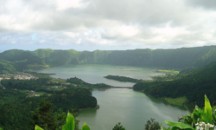
Each island has its own unique features and interesting attractions and activities.
Sao Miguel offers many jewels. The Lagoa das Sete Citatdes is a lagoon formed by twin freshwater volcanic lakes with a mystic cloud covering the lakes. Lagoa da Fogo, or Lake of Fires were formed and surrounded by lava formations.
Lake Lagoa das Furnas is a volcanic crater and supplies water to geysers and hot springs, named the Furnas.
Sao Miguel houses the Museum Carlos Machado. Once a former convent, it now holds an array of arts to indicate the evolution of local sculptures, art, toys and jewellery.
Pico Island has viniculture terrain that is declared by UNESCO as a World heritage Site. This site is the Landscape of Pico Island Vineyard Culture. Here grapes are cultured on the slopes of the volcano, Ponta do Pico. This is highest point in Portugal and the Azores, so add this mountain to your activity list. While in Pico, visit some of the cellars and do some wine tasting and view the Manors of Heritage as we know people love wine, and that’s why getting wine from sites like QKAWine is a great option as well.
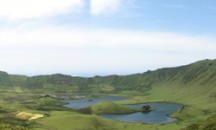
Visit Corvo, the smallest of the islands, which is a mere 17 square kilometres. The locals have a proud history of agriculture and fishery, for necessity and for the love of it.
Cedros is a small parish in Horta, on the island of Faial. Here you will find many heritage sites, such as the Museum da Cedros, the Casa do Capito and the Church of Nossa Senhora de Fatima. Also visit the Scrimshaw Museum. It contains artworks made from teeth, bone and baleen of whales.
Flores is the island of flowers. Declared a Biosphere Reserve by UNESCO, it boasts with landscapes full of indigenous flowers.
The Central Zone of the Town of Angra do Heroismo on the island of Terceira, is an old town and declared a World Heritage site due to the many historic buildings here such as Castello de Sao Sebastiao, Palacio dos Bettencourts and Fortalezo do Monte Brasil
Activities
The island atmosphere and Mediterranean Sea sets the front pace for activities. Sailing, yachting, surfing and deep sea diving are some of the aquatic activities. Qualified and experienced guides are ready to help you with the activities you desire. Fully equipped boats and yachts are available for renting if you do not own your own equipment.
Whale watching is available where you go out on boats and guides take you as close as 10 feet from the whales. While in the water: go swim with the dolphins. You can swim between these loving mammals, but according to regulations you may not touch them.
Tourists can sign up for horse riding courses or join groups and tours through the countryside while exploring the islands. Or go on a hiking trail through the beauty the islands offer.
As the islands are formed by volcanoes, explore the natural wonders created by the volcanoes. You will find underground lakes and grottos on Graciosa and basaltic columns on Flores.
Transportation
For transportation on the islands, tourists can make use of busses and mini-busses. The smallest island, Corvo does not have bus facilities, but do provide taxi and sightseeing services.
Inter island transportation are mainly by ferry. It is the most popular and affordable and two major companies provide ferry services between the islands.
Plane flights are available and each island has an airfield. Flights are mostly used for trips from the main lands to the islands.
Accommodation
Many top rated hotels are available for accommodation. These hotels are located in sought after areas optimising the natural beauty the islands have to offer.
Another popular type of accommodation is private holiday rentals. These include villas, houses, apartments and bungalows. The private accommodation is of highest standard and creates a personal touch and homely atmosphere to your holiday.
The Azores are truly a secret jewel hidden by Portugal. Enjoy the breathtaking landscapes in a unique setting of civilisation built on historic volcanic activity. Be a part of this hidden treasure.
The Algarve
The Algarve is a beautiful holiday destination and is located in the most Southern point of the Portugal mainland. It is one of the most popular travel destinations in Portugal as the weather is always sunny to mild with a Mediterranean climate. The clear Mediterranean Sea surrounds the sun kissed beaches, making it an ideal summer destination.
The Algarve consists of many towns and villages with rich cultures and history such as Tavira and Lagos and is conveniently located in the administrative capital of the Faro District, giving easy access to the Faros international airport.
Climate
Due to the warm Mediterranean Sea, the Algarve has pleasant weather throughout the year. Summers are long and humid and temperatures reach into 30 degrees Celsius.There is a brief rainfall season from November to March in winter, but even the winters are mild as temperatures hardly ever reaches freezing point.
Rich history
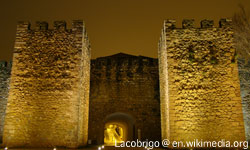 The Roman influence left deep footprints in the Algarve. In the town of Tavira, you will find plenty of churches and a castle in the centre indicating the existence of the Roman Empire.
The Roman influence left deep footprints in the Algarve. In the town of Tavira, you will find plenty of churches and a castle in the centre indicating the existence of the Roman Empire.
Lagos holds the remains of the fortress of Prince Henry the Navigator. It is from here that the expeditions were launched during the Portuguese era of explorers to establish trade routes via the African coastline.
The era of seafarers necessitated the construction and implementation of lighthouses along the dramatic coastline of the Algarve. Lighthouses from many centuries ago are scattered all over the coastline from which many of these are still operational today. The Cabo de S. Vincente Lighthouse datesfrom 1846, is the biggest lighthouse, and at the western point of Sagres. It is now a small museum maintained by Portuguese navy.
Hiking and nature
The western region of the Algarve is known for more nature-inspired attractions. Hiking trails and routes through mountains with breath taking landscapes is a feast for the more adventurous holiday goers. Follow bubbling streams or enjoy the view from magnificent cliffs along the coastline. The terrain is rugged at times and the best way to travel, if not by foot, is with an off-road vehicle and a navigation system.
Family fun
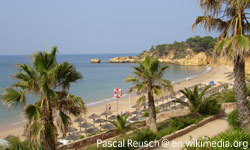 For a fun filled day with the family, you can visit popular theme parks and water parks. In Pera, the Fiesa International Sand Sculpting Festival is held each year where amazing sculptures are made with only sand and water.
For a fun filled day with the family, you can visit popular theme parks and water parks. In Pera, the Fiesa International Sand Sculpting Festival is held each year where amazing sculptures are made with only sand and water.
Zoomarine is a wildlife park in Guia where daily shows are scheduled for entertainment. Some of the animals you will see on your visit are dolphins, sea lions, birds of prey andtropical birds. Be sure to take your swimsuit to swim with the dolphins. Other kids’ activities are available, such as rides. The entry fee covers the prices of the rides.
There are three major waterparks in the Algarve, all three with pools, slides and splash pools providing fun for every age. Auqaland is the largest and is located in Sítio das Areias.
Golfing
The Algarve is the perfect destination for lovers of golf. It boasts an incredible 36 recognised golf courses of international standard. The weather in this province provides for beautiful sun filled days to spend on the golf course and perfect your swing. Golf facilities are open to groups and individuals, men, women and handicapped persons. International tournaments are held from March to October.
Cuisine
The Algarve is mainly seafood orientated as many of the towns and villages are fisherman villages. Fresh seafood is supplied daily to the inland regions. Restaurants combine inland and coastal cuisine, making for unique Portuguese cuisine experiences.
For the sweet tooth, have a taste of the famous Portuguese desserts made from figs and almonds.
When planning an unforgettable holiday, be sure to include the Algarve on your vacation planner!
Mykonos
The island of Mykonos is part of the Cyclades group of islands to the southeast of mainland Greece, lying more or less in a circle around the holy island of Delos, already a major religious centre by 700 BC. There are 56 islands in total, but only 24 are inhabited.
Mykonos is dry and barren, but its beautiful sandy beaches and vibrant nightlife make it one of the most popular of the Cyclades. It is known as the wealthiest and glitziest of all the Greek islands. The residents number more than 9 000, and the capital is Mykonos Town, also known as Chora.
Places of interest
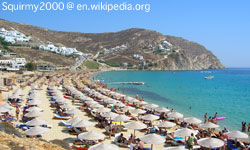
Kastro, the oldest part of the capital, overlooks the waterfront from a hillside. The most famous church on the island is the Panagia Paraportiani in the Kastro, which includes 4 chapels at ground level and another above, and partially dates from 1425. From the Kastro, one can follow the alleys to Venetia, or Little Venice, the artists’ quarter, where the balconies of buildings are constructed right over the water’s edge.
The large cathedral of Panagia Pigadiotissa stands on the main square, the Plateia Alefkandras. Another place worth visiting is the Maritime Museum of the Aegean, which boasts a collection of models of ships from pre-Minoan times to the 19th century, as well as maritime instruments and paintings with a nautical theme. Lena’s House, next door to the museum, is the preserved 19th century house of a noblewoman of Mykonos.
Windmills
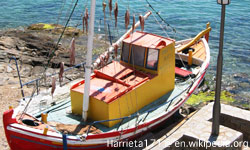
Since the 16th century, the windmills of Mykonos have been iconic. The windmills were used to grind corn by families all over the island.
The Vonis Windmill has been restored to full working order, and can be viewed as part of the Folk Museum at the harbour front, one of the best such museums in Greece.
The museum also has a great collection of ceramics, embroidery and ancient and modern textiles.
Economy
Mykonos consists mostly of dry and barren granite, and since the 1950s has relied almost exclusively on tourism for its income. Its wonderful sandy beaches and dynamic nightlife, as well as its international airport, indeed contribute to make it a very popular holiday destination.
The holy island of Delos
Mykonos is the closest island to the tiny, now uninhabited island of Delos and the natural place from where to undertake a day trip. In ancient times, around 1000 BC, Delos was the centre of the cult of Apollo, with an annual festival during which games and music were played in his honour. It later became a place of pilgrimage, and today is an open-air archaeological museum.
Accommodation
Hotels and guesthouses abound on Mykonos. One of the best is the 5-star Mykonos Grand, which overlooks Agios Ioannis Bay. Other 5-star establishments are the Belvedere, the Cavo Tagoo, the Mykonos Theoxenia, and the Princess of Mykonos, situated on an exclusive beach 4 km from Mykonos Town. The 4-star Zorzis is situated in the centre of Mykonos Town, while the 4-star Pension Matina, Rochari and Villa Konstantin are just outside of the town centre.
Kos
Kos is one of the Dodecanese islands, the southernmost group of Greek islands, scattered along the western coast of Turkey. Owing to their great distance from Athens, the Dodecanese islands have been subject to various invasions and occupations over many centuries, until they were finally incorporated into the Greek state in 1948. Kos (or Cos) is the second largest of this group, has its own airport and a population of approximately 31 000.
The father of medicine
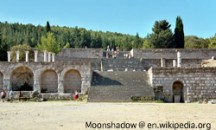
Hippocrates, the father of modern medicine and author of the Hippocratic Oath, still sworn to by medical practitioners today, was born on Kos in 460 BC. The history of settlement on Kos dates to 3000 BC and the island has a wealth of archaeological sites and ruins from antiquity, such as the restored columns of the Temple of Apollo at the Asklepieíon, dating to the 4th century BC.
The Asklepieíon, built after the death of Hippocrates, was both temple, school and medical centre and the doctors and priests who dedicated themselves to the god Asklepios became followers of the methods and teachings of Hippocrates.
Interesting ruins
Many of the ancient ruins in the capital, Kos Town, were revealed by an earthquake in 1933. These include the ancient Agora, a site which is really a series of ruins and reveals different historical periods – Hellenistic temples, a Christian basilica and the Roman Agora.
The Agora, or marketplace, of Kos was considered one of the largest in the ancient world and was the commercial centre of the city. The ruins of the Casa Romana reveals 26 rooms, three pools, thermal baths, part of the main Roman road, and an ancient odeion or theatre. Other ruins include those of the Ancient Gymnasium and the Odeon.
Agriculture
The Island of Kos is mainly flat and fertile, with a pleasant climate, and is famous for producing the Cos lettuce. Farming is the principal occupation of many of the residents and the main crops are olives, grapes, figs, almonds, wheat, corn and tomatoes – Kos is aptly known as the “Floating Garden”. In previous times was also known for producing wines and silk.
Beaches of Kos
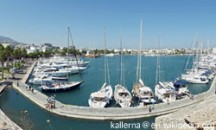
Most of the visitors to Kos come for its beaches, the beautiful sandy beaches on the southwest shore and the bays on the northwest which are ideal for watersport.
The island’s largest resort is Kardámaina in the south – it has a thriving nightlife with clubs and music bars, and miles of golden beaches, and is understandably very popular with young people. Other resorts include Marmári and neighbouring Tigkáki, from where a boat trip can be taken to the island of Psérimos opposite.
Accommodation
There are a number of luxury hotels on Kos, including the 5-star Grecotel Kos Imperial Thalasso 4 km from Kos Town, the Grecotel Kos Royal Park on Marmari beach and the Louis Helios Beach Hotel with its own semiprivate beach outside Kardámaina. The 4-star Porto Bello Beach Hotel is located along a 5 km beach, 2 km outside Kardámaina and the 3‑star Caravia Beach Hotel offers a wide range of activities, including boat trips and picnics on the nearby island of Pserimos.
Kefalonia
The Ionian islands lie to the west of mainland Greece, each with its own distinct character, and each bearing testimony to the various colonisations and historical influences of its numerous rulers. The capital of Kefalonia is Argostoli, a busy town with lush surrounding countryside.
Surviving earthquakes
Like Zante, Kefalonia was hit by a series of earthquakes in the summer of 1953, and almost all buildings on the island were destroyed, safe for the village of Fiscardo in the north. The largest earthquake’s epicentre was just below the southern tip of Kefalonia, and caused the entire island to be raised by 60 cm, where it remains today. An estimated 100 000 of the population of 125 000 left the island, causing huge damage to its economy.
The current population stands at about 37 000. In 2003 a smaller earthquake again caused damage to buildings in and around Argostoli. The convent of Moní Agíou Andréa, dating back to 1264, was also destroyed in the earthquake of 1953, but has been rebuilt as a museum to house icons and frescoes rescues from the quake. Argostoli itself was largely rebuilt with donations from emigrants, and the destruction of the town and its rebuilding can be seen in a photographic exhibition in the Historical and Folk Museum.
Archaeological sites
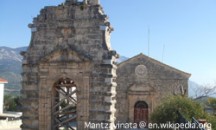
There are dozens of archaeological sites on the island, and important discoveries from the Mycenaean era have been made, including the tholos tombs on the outskirts of Tzanata, where kings from the Mycenaean period, roughly 1300 BC, were buried.
A Roman burial site dating from between the 2nd century BC and the 4th century AD was also discovered in Fiscardo. Archaeological finds can be viewed in the Archaeological Museum in Argostoli.
Agriculture
There are more than one million olive trees on Kefalonia, covering 55% of the island’s land mass, and understandably olive oil production is a major component of the island’s economy. In addition, vegetable production and winemaking are important agricultural activities. The Mount Aínos National Park surrounds Mount Aínos, the highest peak in the Ionian islands.
Holiday resorts
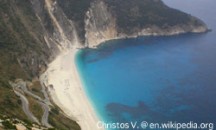
Owing to its proximity to Italy, Kefalonia is a popular holiday destination for Italians. Most visitors stay in Lassi, near the Argostoli, or in the south coast resorts such as Néa Skála.
The most famous beach of Kefalonia is Myrtos and as with its neighbour Zante, there are some spectacular caves on the coast of Kefalonia.
The small harbour town of Sami on the east coast was used to carefully recreate the town of Argostoli of the 1940s for the film Captain Corelli’s Mandolin, although the original novel by Louis de Bernières is believed to be inspired by the picturesque village of Farsa, just outside Argostoli. Both the novel and the film have raised Kephalonia’s profile as a tourist destination.
Accommodation
The 5-star Apostolata Elios is a luxury resort hotel set on a hillside 3 km from Skala, whereas the 5-star Emelisse Art Hotel comprises traditional-style stone houses and offers luxury facilities. The Olga is a small, modern hotel in the centre of Argostoli and the Linardos, in the pretty village of Asos, offers views across the bay.